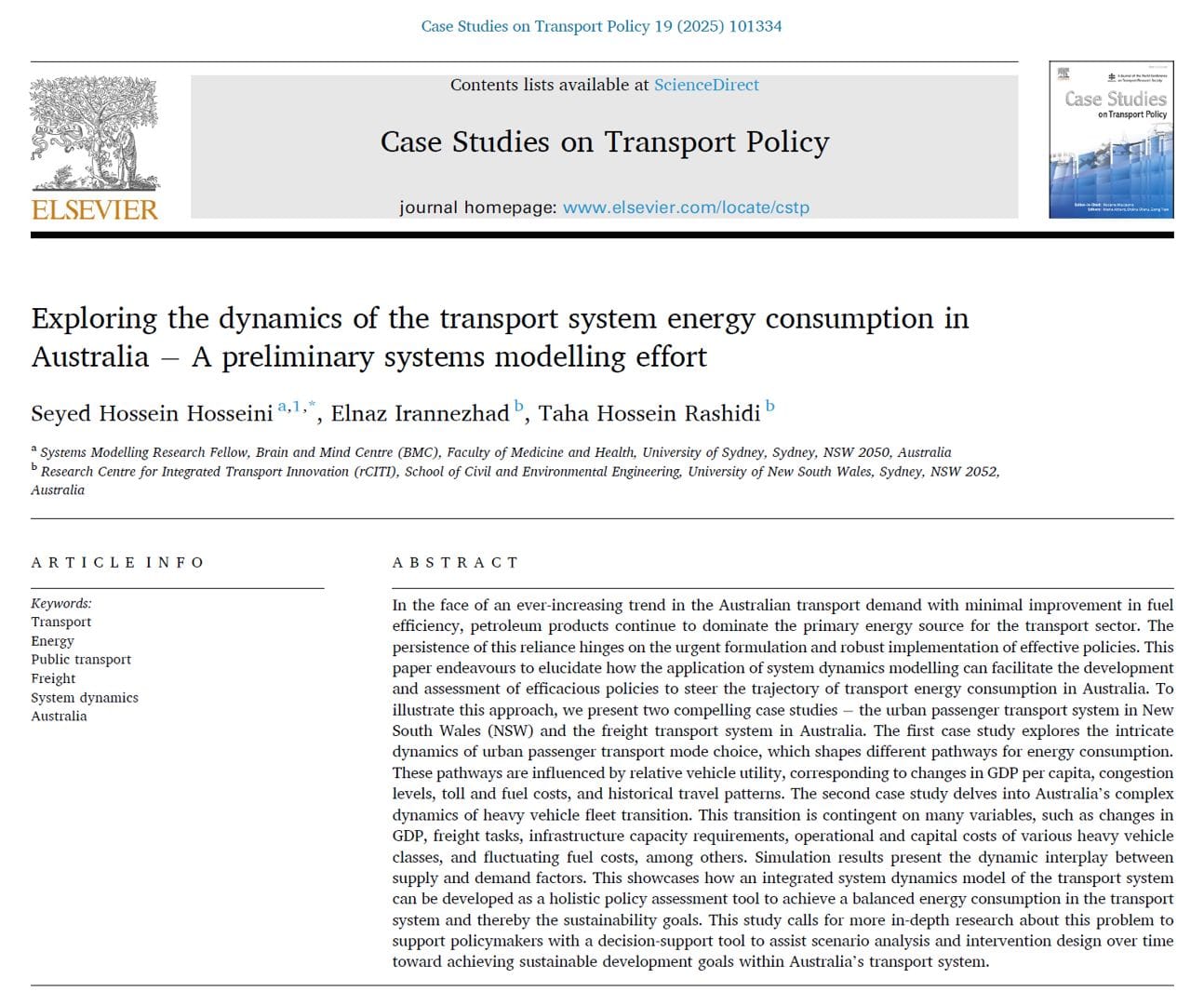
I am excited to share my recent publication, entitled “Exploring the dynamics of the transport system energy consumption in Australia − A preliminary systems modelling effort” that just published in “Case studies on Transport Policy”, Elsevier.
Table of Content
As part of my previous research, this work explores the dynamic interplay between transport systems and energy consumption in Australia, showcasing the power of system dynamics modelling to tackle intersectoral, complex transport challenges.
🔍 𝗪𝗵𝗮𝘁 𝘄𝗲 𝗱𝗶𝗱:
We developed two preliminary system dynamics models to explore:
𝗣𝗮𝘀𝘀𝗲𝗻𝗴𝗲𝗿 𝘁𝗿𝗮𝗻𝘀𝗽𝗼𝗿𝘁: Our model revealed that reducing personal vehicle use and boosting public transport use must align with improving public transport fuel efficiency to keep energy consumption in check, highlighting the importance of integrated policy measures to drive sustainable urban transport shifts.
𝗣𝗮𝘀𝘀𝗲𝗻𝗴𝗲𝗿 𝘂𝗿𝗯𝗮𝗻 𝘁𝗿𝗮𝗻𝘀𝗽𝗼𝗿𝘁: Understanding the dynamics of urban transport energy consumption and potential future pathways.
𝗙𝗿𝗲𝗶𝗴𝗵𝘁 𝘁𝗿𝗮𝗻𝘀𝗽𝗼𝗿𝘁: Simulating fleet transitions and their energy consumption trajectories up to 2050.
📈 𝗞𝗲𝘆 𝗳𝗶𝗻𝗱𝗶𝗻𝗴𝘀:
𝗙𝗿𝗲𝗶𝗴𝗵𝘁 𝘁𝗿𝗮𝗻𝘀𝗽𝗼𝗿𝘁: By 2050, the dominance of diesel rigid trucks will diminish, with Battery Electric Trucks (BETs) and Fuel Cell Trucks (FCTs) emerging as viable alternatives (contributing to 30.3 % of the total freight demand carried in 2050). Additionally, articulated diesel trucks will lead the freight market, contributing over 56% of total demand.
This research calls for further exploration of environmental impacts, behavioural dynamics, and infrastructure trade-offs to enhance policy design for sustainable transport systems.
Special thanks to my coauthors, Elnaz (Elli) Irannezhad and Taha Rashidi, who made invaluable contributions to this work.
Access the paper
The paper is accessible HERE
Title
Exploring the dynamics of the transport system energy consumption in Australia − A preliminary systems modelling effort
Highlights
- Developed two system dynamics models, integrating energy and transport systems.
- Passenger transport model reveals key energy consumption drivers and trajectories.
- Freight transport model simulates dynamics of fleet and fuel transitions by 2050.
- Capturing critical feedback loops in the energy and transport systems’ interplay.
- Diesel rigid trucks to shift to greener fuels, with articulated trucks dominating 2050.
Abstract
In the face of an ever-increasing trend in the Australian transport demand with minimal improvement in fuel efficiency, petroleum products continue to dominate the primary energy source for the transport sector. The persistence of this reliance hinges on the urgent formulation and robust implementation of effective policies. This paper endeavours to elucidate how the application of system dynamics modelling can facilitate the development and assessment of efficacious policies to steer the trajectory of transport energy consumption in Australia. To illustrate this approach, we present two compelling case studies − the urban passenger transport system in New South Wales (NSW) and the freight transport system in Australia. The first case study explores the intricate dynamics of urban passenger transport mode choice, which shapes different pathways for energy consumption. These pathways are influenced by relative vehicle utility, corresponding to changes in GDP per capita, congestion levels, toll and fuel costs, and historical travel patterns. The second case study delves into Australia’s complex dynamics of heavy vehicle fleet transition. This transition is contingent on many variables, such as changes in GDP, freight tasks, infrastructure capacity requirements, operational and capital costs of various heavy vehicle classes, and fluctuating fuel costs, among others. Simulation results present the dynamic interplay between supply and demand factors. This showcases how an integrated system dynamics model of the transport system can be developed as a holistic policy assessment tool to achieve a balanced energy consumption in the transport system and thereby the sustainability goals. This study calls for more in-depth research about this problem to support policymakers with a decision-support tool to assist scenario analysis and intervention design over time toward achieving sustainable development goals within Australia’s transport system.
Keywords
Transport , Energy , Public transport , Freight , System dynamics , Australia